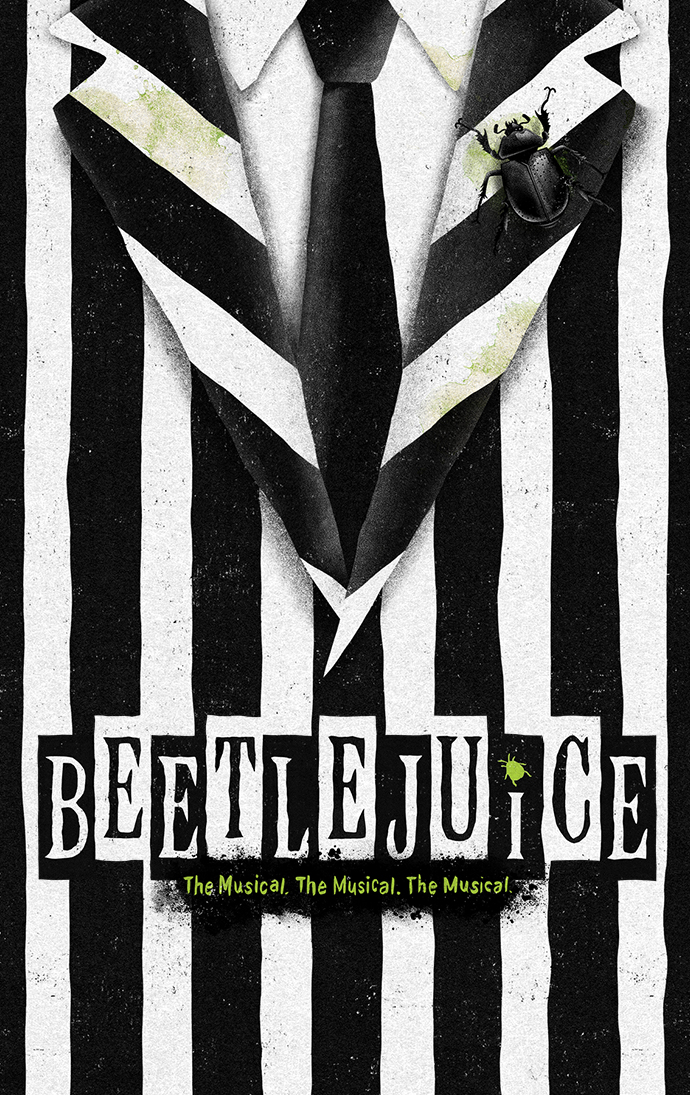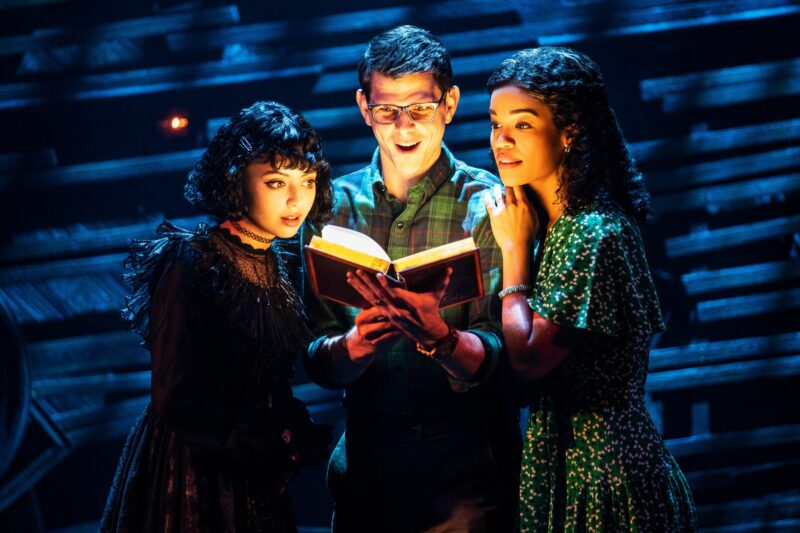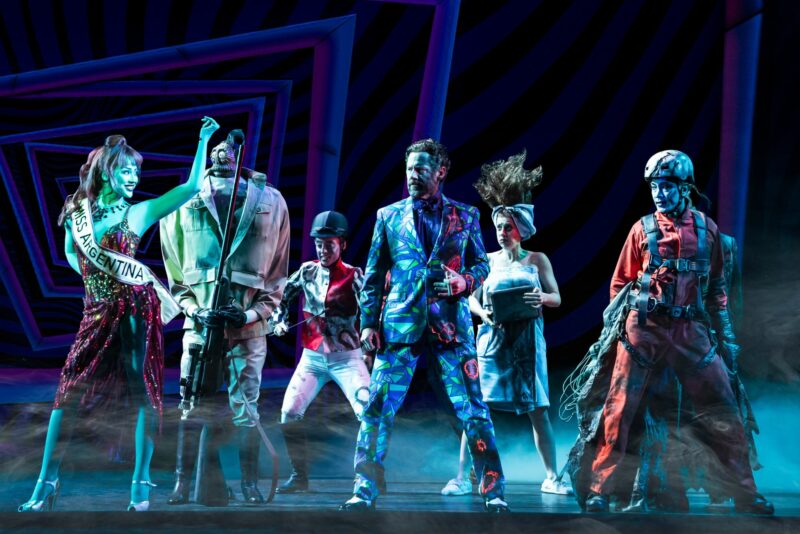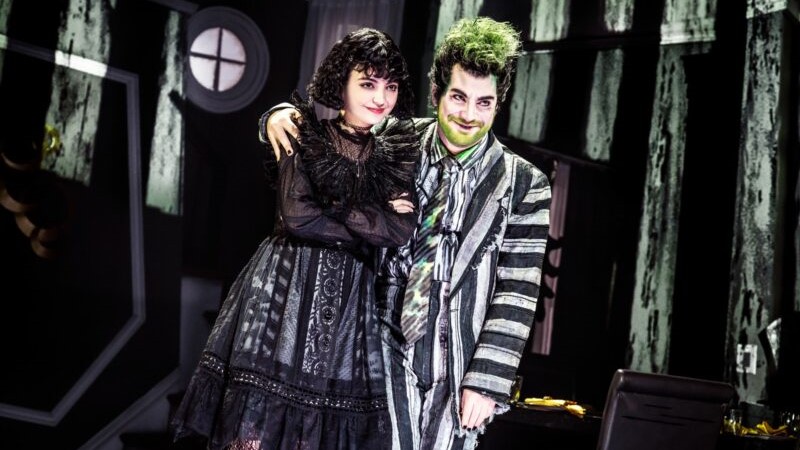SALT LAKE CITY — Beetlejuice (with music and lyrics by Eddie Perfect and a book by Scott Brown and Anthony King) is a technical triumph with non-stop laughs. Beetlejuice is a faithful retelling of the iconic 1988 film of the same name starring Michael Keaton as the titular character. It is a smart choice for a stage adaptation. When I attended opening night of the show in Salt Lake City, I saw many people dressed up as Beetlejuice or wearing pieces of his familiar outfit.

Easily, the piece that stands out in Beetlejuice is the overwhelming use of technical effects. In nearly every scene, the stage has a surprise in store. Even the curtain that drops down for scene changes is used as part of the story (such as when the curtain is used to depict a night scene with trees, ravens). The lighting effects are nearly constant, guiding the audience from one scene to another with flashing bright lights, and sets being flooded with new or different lighting schemes (such as when Beetlejuice hosts a gameshow, and the house is red and yellow) or the rare times when everything is white and black (matching Beetlejuice’s clothing).
The color green follows Beetlejuice around everywhere. For example, in his number “The Whole Being Dead Thing Pt. 2,” the lights shift to green as he sings to the newly dead couple Adam (played by Will Burton) and Barbara (played by Britney Coleman). It is not just green that is often seen on stage, but purple, too, which makes an appearance in the iconic dinner party scene. Here, Maxine Dean (played by Kris Roberts) and Maxie Dean (played by Brian Vaughn) are bathed in purple light while being possessed and singing “Day-O (The Banana Boat Song).” This particular purple/pinkish hue indicates when the humans are possessed and provides some unity to the show’s mayhem.
Perhaps because the musical lacked an emotional core (it is basically held together by Beetlejuice’s never-ending topical humor) the lights feel like a way to fill in those gaps. The lighting effects give the audience something to look at, although the musical does not give audience members much time to stop and think. Yet, I did appreciate that the script did not recreate the movie’s scenes exactly. Instead, it stays faithful to the best parts of the film, while still introducing new characters.

Andrew Kober, as Beetlejuice, is in a word: perfect. Beetlejuice is pure comedy, and like many of the other characters, is significantly more engaging than his counterpart in the film. As the titular character, Kober sings a majority of his songs in ensemble (with two exceptions), but much of his strength is as a comedian, where his numbers regularly use a back-up chorus/dancers combination to comedic effect. It is difficult for even a critic to quibble when Kober delivers all of his lies so well, such as when Beetlejuice is underwhelmed by Adam and Barbara’s ability to be ghosts, and as he’s leaving he says, “Guys.” They turn to look at him: “F*** you,” he finishes, and walks out the door. Kober is the highlight of the show, and it is always a treat when he is in a scene or breaking the fourth wall.
But it is not as if Kober carries the show on his back. Nearly the entire cast. Whenever Kate Marilley (in the role of Delia) appears, a scene is guaranteed to be hilarious, such as when she quotes Otho (played by Abe Goldfarb), saying to Lydia, “Sadness is like a third nipple. It’s a part of you, but no one wants to see it.” Marilley’s Delia is more unhinged than Catherine O’Hara’s interpretation of the character, as in the musical, Delia is a life coach hired by Charles (Lydia’s father, played by Jesse Sharp) to help Lydia overcome her grief over her mother’s death (depicted in the beginning of the musical).
Even Adam and Barbara — who are quite boring in the film — are become entertaining because the show capitalizes on their boring-ness. When Lydia finds them in the attic, she says that they look like owners of a struggling coffee shop, to which Adam replies, “I’ve always wanted to be the owner of a struggling coffee shop.” Their moments in the musical are highlighted by Burton’s and Coleman’s use of facial features as they perform gags, such as when they are learning how to haunt their house. Overall, the Adam-Barbara relationship is very adorable and quite believable as a couple with a quiet chemistry that is always enjoyable to watch, a testament to Coleman’s and Burton’s acting prowess.

The only character who is not a laugh riot is Lydia, played by Isabella Esler. Perhaps the reason why Lydia is not really very funny is because her character is the only one that is identical to her cinematic counterpart. Everyone else is very much over-the-top and funnier than the originals. Still, I would be remiss if I did not mention that Esler is a vocal powerhouse who gets two solos in “Dead Mom” and “Home.” It is amazing to listen to Esler perform these songs.
Sadly, Beetlejuice is almost exclusively ensembles or duets, not providing any real opportunity for recurring characters to shine. On one hand, this is a performance where characters are rarely alone and everything happens in groups. But on the other hand, I would have loved to listen to Marilley or Coleman get their own number and really showcase how amazing the female talent is in this cast. Additionally, there are few real emotional moments in Beetlejuice. Interactions that might be tender — such as the earlier ones between Delia and Lydia — are punctuated by humor and later a duet. It is not until Lydia and her father are in the Netherworld together that characters actually confess their feelings and address a longstanding conflict in the story. Not coincidentally, this is a scene when the stage is completely bare, allowing the technical wizardry to finally take a back seat to emotional storytelling.
Still, Beetlejuice is really a wonderful companion piece to the film, and it hits all the highlights that audiences might be expecting: the dinner party scene, the wedding dress, the sand worms and more. I highly recommended Beetlejuice for fans of the film, or anyone who just really wants to laugh from beginning to end of a show and enjoy some great technical effects.
[box]The national tour of Beetlejuice plays Tuesdays through Thursdays at 7:30 PM, Fridays at 8 PM, Saturdays at 2 PM and 8 PM, and Sundays at 1 PM and 6:30 PM at the George S. and Dolores Doré Eccles Theater (131 South Main Street, Salt Lake City). Tickets are $75-225. For more information, visit saltlakecity.broadway.com.[/box]

